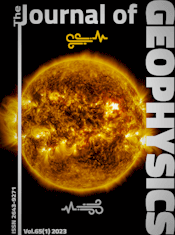The shape of the geomagnetic field through the last 8,500 years over part of the northern hemisphere
Article Sidebar

Vols. 1-18 (1924-1944), ISSN 0044-2801
Main Article Content
Abstract
Regional type curves depicting secular variations of declination and inclination through the last 10,000 calendar years constructed for north-western Europe (356° E, 55° N) and east-central North America (270° E, 46° N) by stacking palaeomagnetic data derived from lake sediment cores are described and analysed. The spectral content and phase relationships of the two pairs of curves show that they have a complex origin with both drifting and standing geomagnetic sources contributing to them. The strongest evidence of drifting sources is provided by the inclination type-curves which exhibit maximum correlation for a phase shift of ~650 years suggestive of westward drift at a rate of about 0.13 degrees a year. At the same time, comparison of the declination type-curves strongly suggests that waxing and waning standing sources were dominant. We show that the difference in relative importance of drifting as compared to standing geomagnetic sources implied by the patterns of correlation deduced respectively for declination and inclination can, at least in principle, be attributed to observation point/geomagnetic source geometry by modelling the secular variation that would be produced by standing but oscillating equatorial dipoles and radial dipoles located deep within the outer core, by a pair of drifting deep-seated radial dipoles of constant intensity, and by drifting sheets of radial dipoles (taken to represent current-loops) located at shallow depth within the outer core. Each of these model sources produces secular variation curves with distinctive shapes and phase relationships. Hence, an attempt is made to identify qualitatively the types and locations of the sources which dominated the secular variations as recorded by our type-curves. One of our most important conclusions is that there appears to be a' turning-point' at ~ 4 750 years before present when the relative amplitudes of the active' standing' sources changed but the characteristics of the drifting sources appear to have remained relatively unchanged.
 ARK: https://n2t.net/ark:/88439/y011535
ARK: https://n2t.net/ark:/88439/y011535
Permalink: https://geophysicsjournal.com/article/263
Article Details
References
Banerjee, S.K., Lund, S.P., Levi, S. (1979) Geomagnetic record in Minnesota lake sediments - absence of the Gothenburg and Erieau excursions. Geology 7:588-591
Barton, C.E. (1982) Analysis of palaeomagnetic time series - techniques and applications. Geophysical Surveys (In press)
Broecker, W.S., Olson, E.A. (1961) Lamont radiocarbon measurements. Radiocarbon 3:176-204
Burg, J.P. (1967) Maximum entropy spectral analysis. 37th Ann. Int. Meeting Soc. Explor. Geophys., Oklahoma City
Burg, J.P. (1968) A new analysis for time series data. Adv. Study Inst. on Signal Processing, NATO, Enshede
Clark, R.M. (1975) A calibration curve for radiocarbon dates VIII. Antiquity XLIX:251-266
Creer, K.M. (1977) Geomagnetic secular variations during the last 25000 years: an interpretation of data obtained from rapidly deposited sediments. Geophys. J. R. Astron. Soc. 48:91-109
Creer, K.M. (1981a) Long period geomagnetic secular variations since 12000 yr B.P. Nature 292:208-212
Creer, K.M. (1981b) Palaeomagnetism of the Quaternary Period. In: Khramov, A.N. (Ed.) Magnetostratigraphy and geodynamics - results of researches on the international geophysical projects, Moscow pp. 16-25 (In Russian)
Creer, K.M. (1982) Lake sediments as recorders of geomagnetic field variations - applications to dating post-glacial sediments. Hydrobiologia, 92:587-596
Creer, K.M., Gross, D.L., Lineback, J. (1976) Origin of regional magnetic variations recorded by Wisconsin and Holocene sediments from Lake Michigan, USA and Lake Windermere, England. Bull. Geol. Soc. Am. 87:531-540
Creer, K.M., Hogg, T.E., Malkowski, Z., Mojski, J.E., Niedziolka-Kroll, E., Readman, P.W., Tucholka, P. (1979) Palaeomagnetism of Holocene lake sediments from North Poland. Geophys. J.R. Abstract Soc. 59:287-314
Creer, K.M., Hogg, T.E., Readman, P.W., Reynaud, C. (1980) Palaeomagnetic secular variation curves extending back to 13400 years B.P. recorded by sediments deposited in Lac de Joux, Switzerland. J. Geophys. 48:139-147
Creer, K.M., Readman, P.W., Papamarinopoulos, S. (1981) Geomagnetic secular variations in Greece through the last 6000 years obtained from lake sediment studies. Geophys. J. R. Astron. Soc. 66:193-219
Creer, K.M., Tucholka, P. (1982a) Secular variation as recorded in lake sediments: a discussion of North American and European results. Phil. Trans. R. Soc., Lond. A 590:87-102
Creer, K.M., Tucholka, P. (1982b) Construction of type-curves of geomagnetic secular variation for dating lake sediments from eastcentral N. America. Can. J. Earth Sci. 19:1106-1115
Denham, C.R. (1975) Spectral analysis of palaeomagnetic time series - techniques and applications. J. Geophys. Res. 80:1897-1901
Mothersill, J.S. (1979) The palaeomagnetic record of the Late Quaternary sediments of Thunder Bay. Can. J. Earth Sci. 16:1016-1023
Mothersill, J.S. (1981) Late Quaternary palaeomagnetic record of the Goderich Basin, Lake Huron. Can. J. Earth Sci. 18:448-456
Rao, C.R., Mitra, J .K., Matthai, A. (1966) Formulae and tables for statistical work. Calcutta: Statistical Publishing Society
Skiles, D.D. (1970) A method of inferring the direction of drift of the geomagnetic field from palaeomagnetic data. J. Geomagn. Geolectr. 22:441-462
Tucker, P. (1979) Selective post-depositional in a synthetic sediment. Phys. Earth. Planet. Int. 20:11-14
Tucker, P. (1980) A grain mobility model of post-depositional realignment. Geophys. J. R. Astron. Soc. 63:149-163
Turner, G.M., Thompson, R. (1981) Lake sediment record of the geomagnetic secular variations in Britain during Holocene time. Geophys. J. R. Astron. Soc. 65:703-725
Yukutake, T., Tachinaka, H. (1968) The westward drift of the geomagnetic secular variation. Bull. Earthquake Res. Inst. Tokyo 46:1027
Yukutake, T., Tachinaka, H. (1969) Separation of the Earth's magnetic field into the drifting and the standing parts. Bull. Earthquake Res. Inst. Tokyo 47:65











